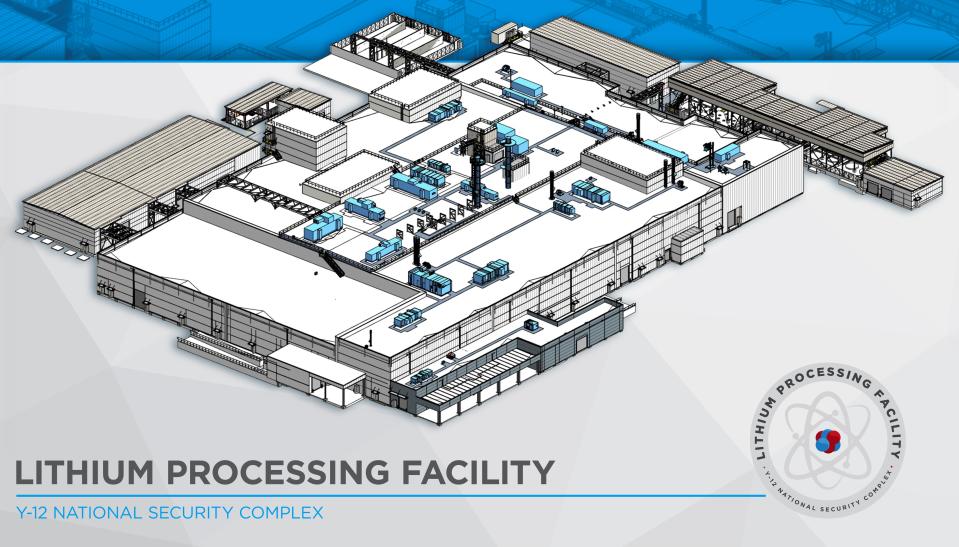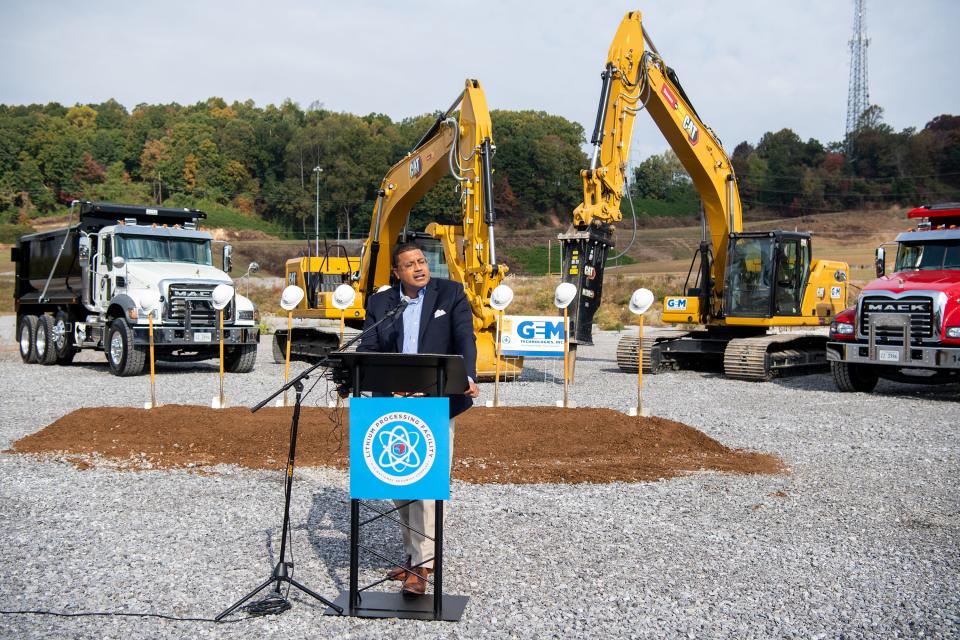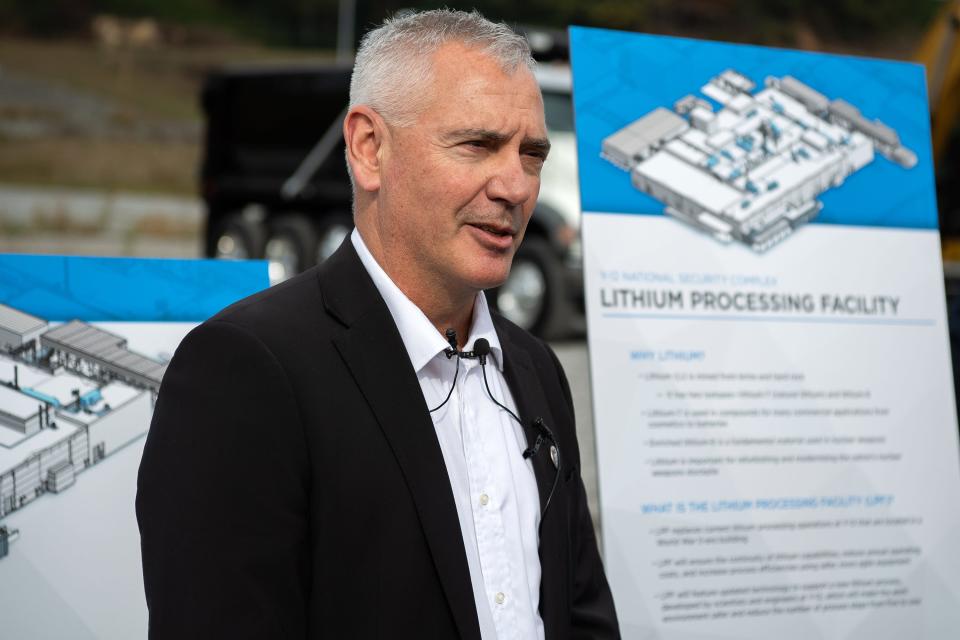Y-12 moving critical lithium operations out of Manhattan Project building
Y-12 National Security Complex broke ground on a sprawling facility that will take nearly 10 years to build and will steward the nation's stockpile of enriched lithium at a perilous moment for global security.
The Lithium Processing Facility will move operations on a critical element in nuclear weapons from a deteriorating Manhattan Project building. Construction on the 245,000-square-foot facility is expected to be completed in 2031, and full operations are expected to begin in 2034. The estimated cost of the project is between $1.2 billion and $1.6 billion.
Y-12 is part of the National Nuclear Security Administration, an agency of the Department of Energy, and is the department's only facility with lithium production capabilities.
The immediate backdrop of the Oct. 19 groundbreaking ceremony was excavators and dump trucks, but the stage was set with invocations of Y-12's critical role in nuclear deterrence at a time when U.S. adversaries are flexing their growing nuclear capabilities.
“Like our Manhattan Project predecessors, today’s NNSA faces a daunting task in a very hostile world,” said Frank Rose, the administration's second-highest ranking official. “Each of our main adversaries are engaged in some kind of destabilizing behavior.”

Standing before the workforce that will build and operate the Lithium Processing Facility, Rose ran through a list of threats to global nuclear security, from Russia and China to Iran and North Korea.
Russia took control of one of the world's largest nuclear power plants early in its offensive against Ukraine. Russian President Vladimir Putin said the country had deployed nuclear warheads to Belarus, closer to Ukraine and to U.S. allies in NATO.
At the same time, China has rapidly expanded its arsenal of nuclear weapons. The nation has more than 500 operational nuclear warheads and will likely have over 1,000 nuclear warheads by 2030, the Pentagon said in its annual report on China's military released Oct. 19.
“We are for the first time confronting the possibility of facing two near-peer nuclear adversaries,” Rose said. "We are asked to do more at a faster pace at any time since World War II. The key to meeting our expanded mission requirements is an enterprise that is resilient and flexible.”
U.S. Rep. Chuck Fleischmann, a regular at Oak Ridge ceremonies, sent a representative from his office. U.S. Sens. Marsha Blackburn and Bill Hagerty also sent representatives in their place.
Staggering investments in Y-12 projects

The National Nuclear Security Administration has bulked up its infrastructure investments as nearly 60% of its facilities nationwide are past their life expectancy. Rose said the push to modernize facilities was most evident at Y-12, which plans to demolish its remaining World War II-era buildings in partnership with the Department of Energy's Office of Environmental Management, beginning with the Alpha-2 building next spring.
In place of outdated buildings are already rising new state-of-the-art facilities. Y-12 celebrated the opening of a new fire station and Emergency Operations Center in January, a combined $68 million investment that piloted a faster, more efficient construction method for the Department of Energy.
A massive new Uranium Processing Facility, the product of decades of careful planning and construction, is quickly moving toward its scheduled completion in 2025. The $6.5 billion project, with a 252,000-square-foot main building, is one of the largest in state history and will allow Y-12 to move uranium processing operations away from Building 9212, which is nearly 75 years old.
Y-12 is designated by the National Nuclear Security Administration as both its Uranium Center of Excellence and its Lithium Center of Excellence, leading the nation's nuclear security around two key ingredients of nuclear weapons. As with uranium, the nation has not enriched lithium since the postwar period, but continues to process and recycle materials in the U.S. stockpile.
“We are the nation’s steward of the stockpile of lithium,” said Gene Sievers, Y-12 site manager. “We don’t go mine and then enrich and then use lithium. We recycle the lithium that we enriched decades ago, and it’s Y-12’s mission to be the careful stewards of that, so we don’t have to go back and engage again in that, what I will just say, chemically hazardous process.”
When Y-12 was built in the 1940s to enrich uranium for the world's first nuclear weapon used in warfare, its buildings were expected to operate for 10 to 15 years. Eighty years later, nine of the original Manhattan Project buildings are still standing and four are still used for critical national security missions.

The highest-risk building is also where Y-12 currently processes lithium, a site called Building 9204-2, or Beta 2. Workers will remain at the facility until the new site is completed.
“We have a really old ship, but a really good crew,” Sievers said. “We invest in that infrastructure to make sure that it’s safe for the workers and it also means that we have to do some additional engineering inspections throughout the year so that we understand how the building is continuing to age.”
Safety upgrades on a site rich with scientific discovery
The Lithium Processing Facility will improve worker and environmental safety with new techniques to minimize the amount of personal protective equipment needed.
It will sit in the 18-acre footprint of the former Biology Complex, a site where Oak Ridge National Laboratory researchers uncovered the effects of radiation on genetics until the 1980s. It was owned by the Department of Energy's Office of Science, which owns ORNL, and was nicknamed the "Mouse House" because of the thousands of unwitting rodent research participants housed there.
When the Biology Complex was fully operational, it was home to more individuals with doctorates than any other facility in the world, according to the Department of Energy.
Both the Uranium Processing Facility and the Lithium Processing Facility are initial steps in a transformational project to modernize Y-12, the Department of Energy's largest employer in the region, one that sits on 811 acres in Bear Creek Valley.
The site, managed by Consolidated Nuclear Security, maintains the U.S. nuclear stockpile, deters nuclear threats worldwide by transporting and storing nuclear weapons materials and provides nuclear fuel for the U.S. Navy, whose submarines and aircraft carriers are powered by nuclear reactors.
Before he came to work at Y-12, Sievers was in the U.S. Navy for 27 years, serving on four nuclear submarines in the Atlantic and Pacific.
“When we cross the blue line and go through the gate of Y-12 every morning, we really stop being normal citizens and we start being national security,” Sievers said. “That is a very empowering and important part of our culture here at Y-12.”
Daniel Dassow is a growth and development reporter focused on technology and energy. Phone 423-637-0878. Email daniel.dassow@knoxnews.com.
Support strong local journalism by subscribing at knoxnews.com/subscribe.
This article originally appeared on Knoxville News Sentinel: Y-12 National Security Complex moving lithium processing

